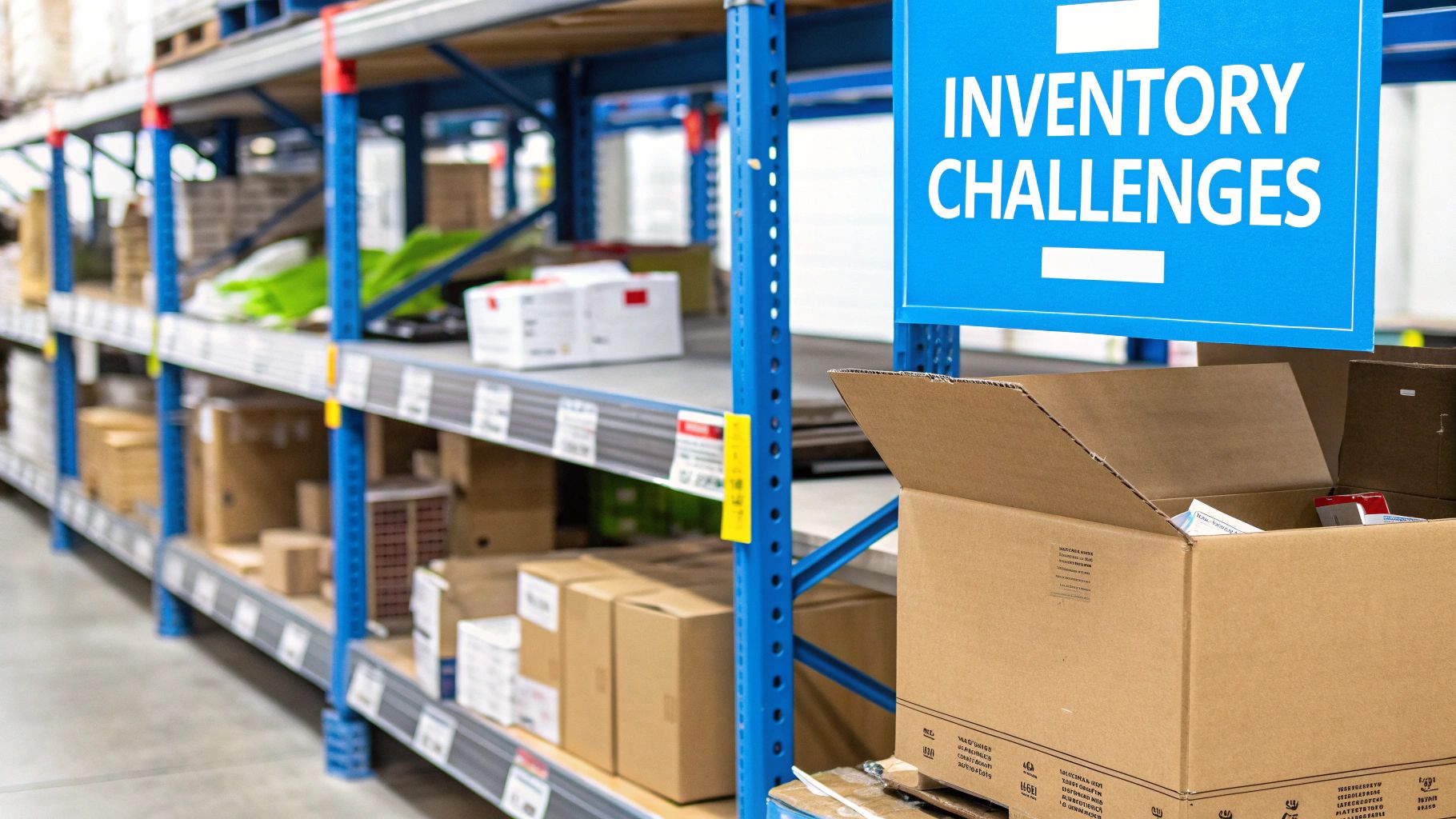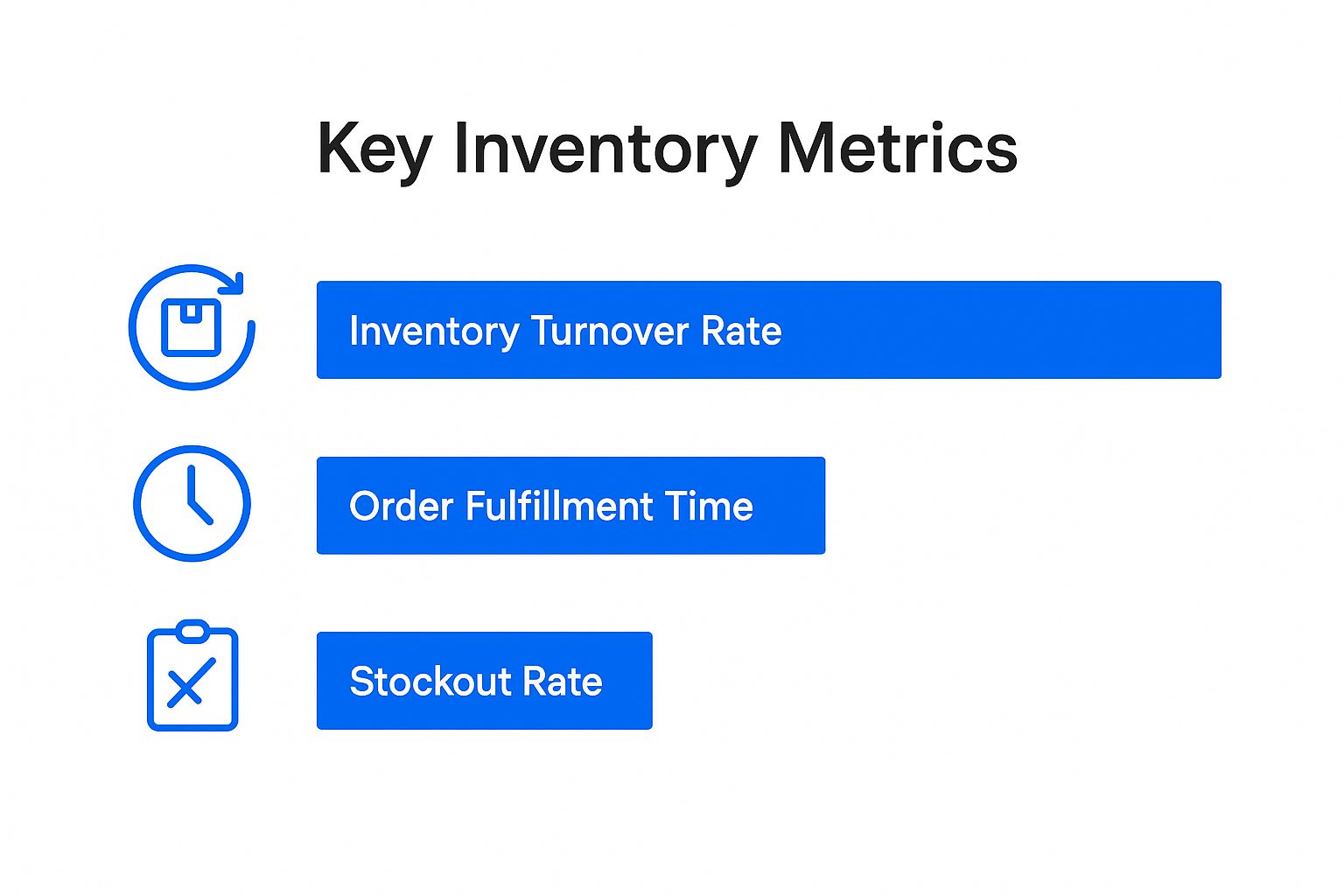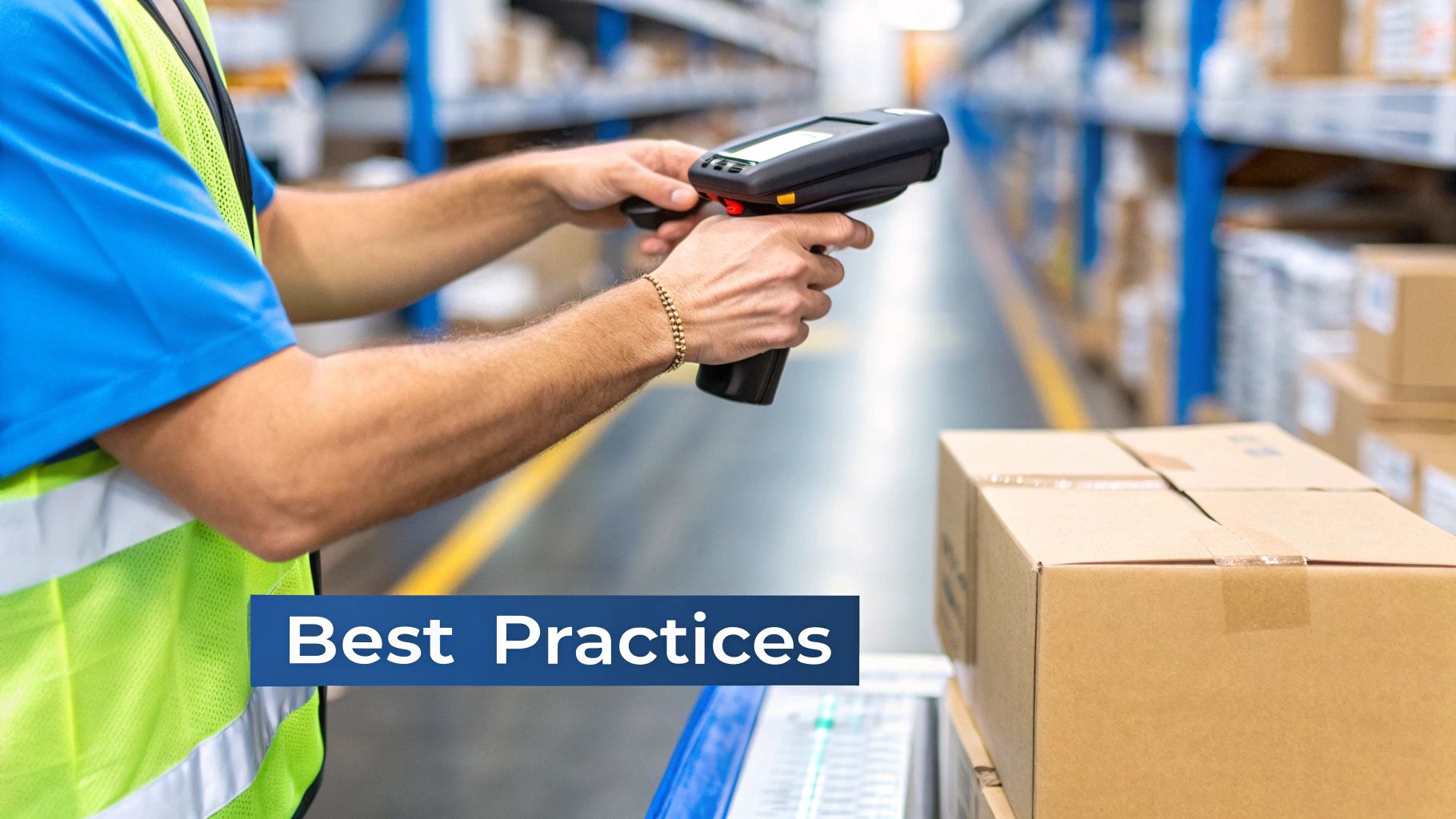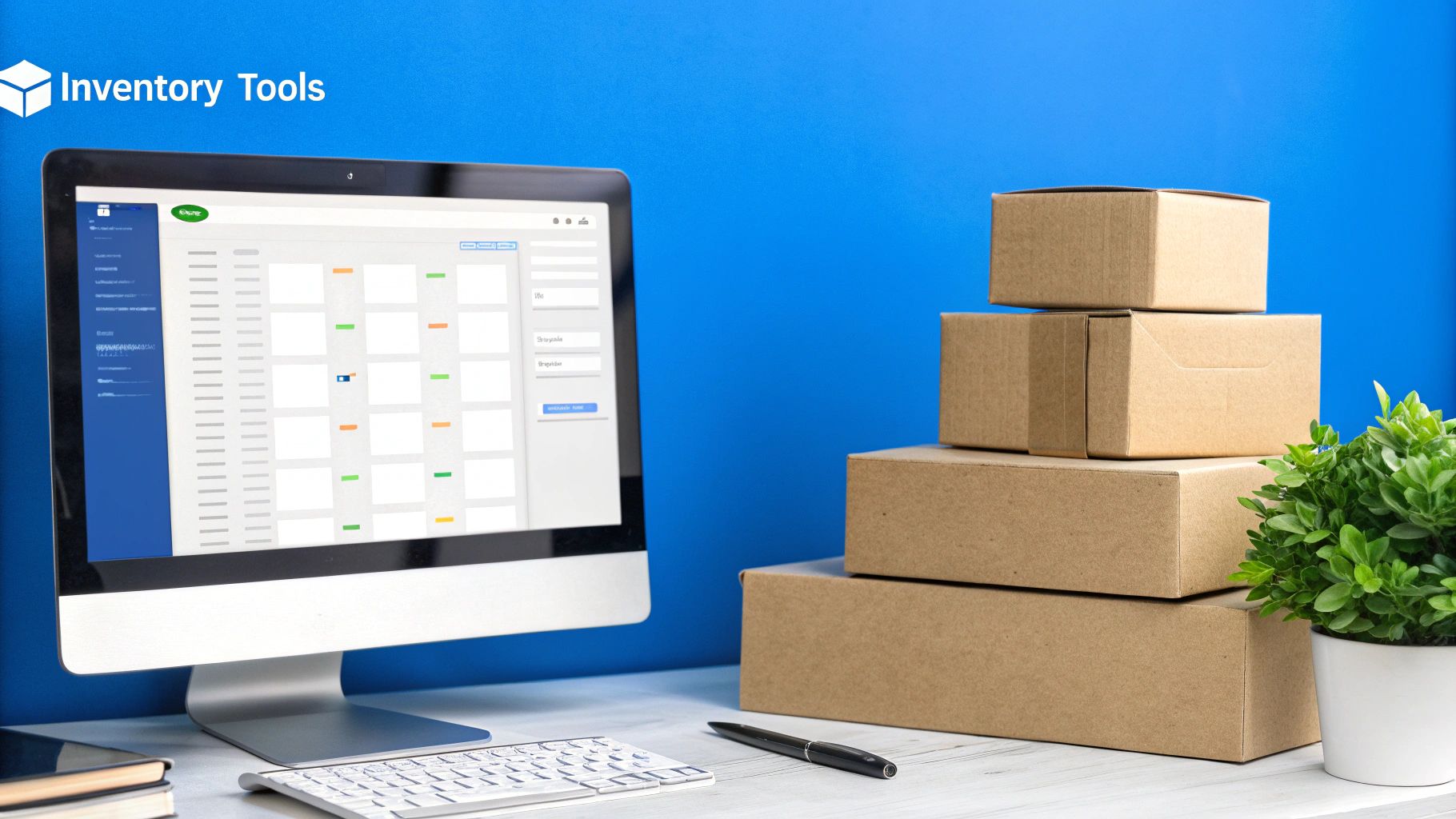Effective subscription box inventory management is the secret weapon that separates thriving brands from the ones that fizzle out. It’s the art of having the exact amount of product you need to delight every subscriber, every single month—without tying up precious cash in dusty, excess stock or, even worse, losing customers to stockouts.
Getting this balance right is what makes that recurring revenue stream truly predictable and profitable.
Let's be honest—inventory is the unsung hero of the subscription box world. Your beautifully curated products and slick marketing campaigns might get all the glory, but poor inventory control can quietly sink your entire operation from behind the scenes.
This is a whole different ballgame than standard e-commerce. You're not just picking and shipping one item at a time. You're orchestrating a symphony of dozens of SKUs into a single, perfect customer experience, delivered like clockwork. The stakes are incredibly high.
One stockout on a key item means you can’t ship complete boxes. That leads to delayed orders and frustrated subscribers who are just a click away from hitting the "cancel" button. On the flip side, overstocking products eats away at your profits through holding costs and locks up capital that you should be using for growth.
Unlike traditional retail, the subscription model throws some unique curveballs at you. Successfully navigating them is what separates the pros from the amateurs.
When you get this right, you can confidently offer things like personalization and add-ons—two of the most powerful retention tools in your arsenal. With accurate inventory data, you can let subscribers "choose their own adventure" without creating a fulfillment catastrophe.
The industry's explosive growth only turns up the heat. The global subscription box market has already swelled to USD 37.5 billion. But analysts are forecasting it to skyrocket to USD 116.2 billion by 2033, fueled by a blistering compound annual growth rate of 13.3%.
With more and more competition flooding this lucrative space, operational excellence isn't just a "nice-to-have." It's a critical differentiator for survival. You can find more insights on the subscription box market's incredible growth at imarcgroup.com.

Forecasting for a subscription box is a whole different ballgame compared to standard retail. You’re not just guessing how many one-off sales you'll make; you're planning for a committed customer base that expects their box to show up on time, every time. This means ditching the guesswork and getting serious about data.
Effective subscription box inventory management is all about blending what you know from the past with what you can predict for the future. It’s how you build a reliable, predictable system that ensures every single subscriber gets the amazing experience you promised.
The best crystal ball you have is your own subscriber data. The first thing you should do is dig into your past shipment cycles to find your baseline. How many active subscribers did you have last month? The month before that? This gives you a solid foundation to build on.
But looking backward is only half the story. You need to layer that historical data with forward-looking insights to get a truly accurate picture.
Start asking yourself these questions:
A single, one-size-fits-all forecast is a fast track to problems. If you offer different box tiers or let customers customize their selections, you absolutely have to forecast for each segment on its own. Your "Premium" box with extra goodies needs a totally separate inventory plan from your "Basic" box.
Let’s say you run a monthly coffee subscription. You might have:
Each of these needs its own forecast. The Standard Roast is likely steady, but the Explorer's Blend demands careful sourcing based on its unique appeal. The Decaf Delight has a smaller, more consistent demand. Breaking it down like this stops you from over-ordering a niche item while making sure you never run out of your best-sellers.
The heart of subscription forecasting is balancing what you know (current subscribers) with what you can reasonably predict (churn, growth, and seasonality). Nailing this balance is what separates smooth sailing from constant fire-fighting.
Subscriber churn—the rate at which customers cancel—is a non-negotiable part of your forecast. If you typically see a 5% monthly churn rate, you have to subtract that expected loss from your inventory count. At the same time, you need to add your projected new subscriber growth.
The basic formula looks something like this:
Forecasted Demand = (Current Subscribers - Projected Churn) + Projected New Subscribers
This dynamic approach gives you a far more realistic snapshot of what you’ll actually need for your next fulfillment cycle. For a deeper look at the nuts and bolts, our guide on how to forecast inventory covers more advanced strategies you can put into practice. Mastering these numbers is the key to smart purchasing and solid subscription box inventory management.
Let's be real: even the best forecasts can be off. That’s where safety stock becomes your best friend. It’s simply the extra inventory you keep on hand to buffer against a sudden spike in demand or a delay from your supplier. A good rule of thumb is to hold 10-20% of your forecasted monthly needs as safety stock.
But you have to be smart about it. Imagine your snack box has a granola bar with a long shelf life and fresh-baked cookies. Holding extra granola bars is low-risk. But for those perishable cookies, your safety stock buffer needs to be much tighter to avoid waste.
Your reorder point is the magic number that tells you it's time to place a new order. This isn't just a gut feeling; it should be a calculated figure based on:
By setting strategic reorder points for every single product, you can automate your purchasing and create a seamless flow of inventory, all while making sure a loyal customer is never disappointed by a stockout.
This is where the magic happens. The kitting and assembly stage is where a pile of individual products transforms into that delightful experience your subscribers can't wait to unbox. But without a disciplined system, this critical step can quickly become a chaotic bottleneck, draining your time and resources. True subscription box inventory management means turning your kitting process into a well-oiled machine that's repeatable, efficient, and ready to scale.
This isn’t just about putting items in a box; it’s about engineering a workflow that crushes errors, maximizes speed, and guarantees every single package reflects your brand's high standards. A well-organized kitting area is the physical heart of your fulfillment strategy.
An optimized kitting station is all about flow and efficiency, not just storage. Think of it as a mini assembly line, even if it’s just a single table in your garage. Every item needs a designated home, and the layout should follow a logical sequence that minimizes how much the packer has to move.
One of the most common mistakes I see is just piling all the component products on a table. Instead, arrange bins or shelves in the exact order items will be placed into the box. This simple tweak takes the guesswork out of the process and dramatically speeds up assembly.
Ready to take it a step further? Here are a few best practices for your setup:
Instead of putting boxes together one by one as orders trickle in, a far smarter method is batching. This means you kit a large number of identical boxes all in one go. Batching helps your team find a rhythm, allowing them to become exceptionally fast at assembling a specific box configuration.
Once a batch of boxes is fully assembled, you need a way to track them as a single, sellable unit in your inventory system. This is where a master SKU comes in. You’ll create a brand-new, unique SKU that represents one completed, ready-to-ship subscription box.
A master SKU essentially "consumes" the individual component SKUs. When you build 100 boxes, your inventory software should automatically deduct the correct quantity of each component product and add 100 units of the new master SKU to your sellable stock. This is critical for preventing you from accidentally selling components that are already reserved for a kit.
The infographic below shows how a well-run kitting process directly impacts key performance metrics.

As you can see, an efficient assembly line has a direct line to reducing order fulfillment time, while precise tracking with master SKUs is your best weapon against stockouts. If you want to dig deeper into this, you can find a detailed breakdown of how to use kitting and assembly to your advantage.
As your subscription box business grows, you'll eventually hit a fork in the road. Do you keep managing fulfillment yourself, or is it time to partner with a Third-Party Logistics (3PL) provider? There’s no single right answer here—the best choice really depends on your business stage, complexity, and growth plans.
Choosing between these two paths is a major strategic decision. To help you weigh your options, here’s a look at the core differences.
Handling fulfillment in-house gives you total control over the unboxing experience. You can personally oversee quality and toss in personal touches on the fly. The flip side is that you’re on the hook for warehousing costs, labor management, and every operational headache that comes with scaling.
Outsourcing to a 3PL that specializes in subscription boxes can be liberating, freeing you to focus on what you do best: marketing and product curation. They already have the space, technology, and experienced team to handle kitting and shipping far more efficiently than most startups can. While it introduces a cost per order, a good 3PL can often secure better shipping rates that partially offset their fees. In fact, a 73% majority of 3PL users report that these partnerships have successfully reduced their overall logistics costs.
Ultimately, the decision to outsource is a strategic one. If your order volume is eating up all your time and you're tripping over boxes in your office, it’s a strong sign that it might be time to explore a partnership. A 3PL can turn your subscription box inventory management from a growth obstacle into one of your most powerful assets.

Let's be honest, manual spreadsheets and sheer guesswork can only carry you so far. As your subscription box business starts to take off, the right inventory management software (IMS) becomes the central nervous system of your entire operation. It quickly shifts from a "nice-to-have" tool to an absolute necessity for accurate, scalable subscription box inventory management.
Think of it as graduating from a basic calculator to a powerful financial computer. A good system doesn't just count your stock. It automates the mind-numbing tasks, gives you a real-time view of what you actually have on hand, and serves up the data-driven insights you need to make smarter business decisions.
Not all inventory platforms are built the same, especially when you factor in the unique demands of a subscription model. As you start looking at different options, there are a few non-negotiable features that should be at the very top of your checklist.
Beyond these fundamentals, you’ll want to look for features that directly support the subscription box model, like robust kitting and bundling capabilities and strong reporting tools. For more practical advice on wrangling your inventory, check out our detailed guide on inventory management tips and tricks.
The real magic of an IMS is unlocked through automation. It takes all the repetitive, error-prone tasks off your team's plate, freeing everyone up to focus on high-impact activities like marketing, customer service, and curating your next amazing box.
Imagine this: no more manually updating a spreadsheet every time you assemble 100 boxes. With an IMS, you define the "recipe" for your finished box (your master SKU). When you tell the system you've built 100 kits, it automatically deducts the right quantities of all the component products and adds 100 units of the finished box to your sellable inventory. It's that simple.
This automation also extends to purchasing. Instead of manually checking stock levels and creating purchase orders, the software can generate POs for you based on your low-stock alerts and sales velocity. This creates a much smoother, continuous flow of inventory and helps you avoid those costly last-minute rushes to your suppliers.
The perfect software for a startup with 50 subscribers is completely different from what a brand with 5,000 subscribers needs. Here’s a breakdown of how to think about your tech stack based on where your business is today.
At this stage, your main priorities are simplicity and affordability. You don't need a massive, enterprise-level system. Honestly, the native inventory tools built into your e-commerce platform (like Shopify Inventory) combined with a well-organized spreadsheet system can be enough to get you off the ground.
If you need a bit more power, look for lightweight, dedicated inventory apps that nail the basics: real-time syncing and simple bundling. The goal here is to build good habits early on without overinvesting in features you won't use for a while.
Okay, you're officially outgrowing the basics. Trying to manage hundreds of orders and increasingly complex kits on spreadsheets is now a huge liability. It’s time to invest in a dedicated Inventory Management System.
At this level, you need a platform that delivers:
This is the turning point where the cost of the software is easily dwarfed by the money you save from preventing stockouts, reducing dead stock, and freeing up your own valuable time.
This investment is critical. The subscription box industry is booming, especially in North America, with a projected compound annual growth rate of 16.8%. This rapid expansion means operational efficiency is the key to capturing market share. A scalable system is no longer a luxury—it's a requirement for survival and growth.
Once you blow past the 5,000 subscriber mark, your logistics get a whole lot more complex. You’re likely dealing with a full warehouse team, multiple suppliers, and maybe even international shipping. At this scale, your inventory management software often becomes part of a larger ecosystem that could include a Warehouse Management System (WMS) or even an Enterprise Resource Planning (ERP) system.
The name of the game here is integration. Your software must connect seamlessly with your 3PL partner's system, your accounting software, and your customer service platform. The goal is to create a fully connected operational backbone that gives you complete visibility from the supplier all the way to your subscriber's doorstep.

Smart inventory management is about so much more than just counting what’s on your shelves. For the top subscription box brands, inventory data is a goldmine—a strategic asset that fuels smarter decisions, boosts profitability, and keeps subscribers coming back for more.
When you move past basic stock counts and start digging into the financial metrics, you unlock the true power of your inventory. This is how you transform your warehouse from a cost center into a genuine profit engine. You start to see not just what you have, but how hard every single dollar tied up in products is working for you.
Think of your inventory as cash sitting on a shelf. To know if that cash is making you more money, you need to track a few key financial metrics. These KPIs reveal the true health and efficiency of your subscription box inventory management strategy.
The two most powerful metrics I always recommend tracking are the inventory turnover ratio and Gross Margin Return on Inventory (GMROI).
Your inventory turnover ratio tells you how many times you sell through your entire stock in a given period. A high ratio is a great sign; it means products are flying off the shelves efficiently. A low ratio, however, is a big red flag that you're overstocked and your cash is just sitting there, collecting dust.
But GMROI is where the real magic happens. It shows you exactly how much gross profit you earn for every single dollar invested in inventory. This is the ultimate report card for your products, helping you spot the true money-makers and identify which items are secretly dragging down your margins.
Think of it this way: Inventory turnover is your speed, while GMROI is your profitability. You absolutely need both to win. A fast turnover on a low-margin item might feel like a win, but GMROI will tell you the real story—whether it's actually building a healthy, sustainable business.
We all know it’s cheaper to keep a customer than to find a new one. In the subscription world, that’s gospel. Retention is everything. A single inventory mistake, like a stockout on a "hero" product that everyone's excited about, can be all it takes for a subscriber to hit the cancel button.
This is where meticulous inventory accuracy becomes your secret weapon for retention.
When your inventory data is rock-solid, you can confidently offer the kinds of features that make subscribers feel valued and stick around for the long haul. Things like:
Trying to offer these perks without precise inventory data is like walking a tightrope without a net. You risk promising an item you don't actually have, which leads to fulfillment nightmares, angry emails, and disappointed customers. Effective subscription box inventory management is the operational backbone that makes these high-value experiences possible.
Holding onto inventory you don’t need is incredibly expensive. We call these holding costs—the expenses tied to storing unsold goods—and they can include everything from warehouse rent and insurance to the cost of the capital tied up in that stock. These costs can easily eat up 20-30% of your inventory's value every single year.
By using your inventory data to fine-tune your forecasting and purchasing, you can slash these costs. Data helps you order much closer to your actual demand, minimizing idle stock and freeing up cash that you can pump back into marketing, product development, or just making the customer experience even better.
Good data also gives you leverage with suppliers. When you can show a vendor predictable, consistent order volumes, you’re in a much stronger position to negotiate better pricing or more favorable payment terms. Even a 5% reduction in your cost of goods can have a massive impact on your bottom line.
Ultimately, every piece of this puzzle circles back to increasing your subscriber lifetime value (LTV). You reduce churn by ensuring products are always available. You improve margins by cutting costs. And you create boxes people genuinely love by using data to curate better products.
This direct line between smart operations and happy, long-term customers is what separates the good brands from the great ones. Industry data shows that around 45% of fashion subscription box subscribers stick around for over a year, a level of loyalty that’s almost impossible to achieve without a reliable inventory system backing you up.
Optimizing these operational details, from inventory to packaging, is where you find hidden profits. To dig a little deeper into this, you might find our guide on the secrets to cheaper subscription box shipping helpful—it shows just how much those small operational tweaks can add up.
Even with the best game plan, you're bound to hit a few snags when you're in the trenches of subscription box inventory management. I've seen it all, and certain questions pop up time and time again. Let's tackle those frequent sticking points with clear, straightforward answers to help you get unstuck and scale your business with confidence.
One of the biggest headaches for subscription brands is figuring out what to do with returns and exchanges. It's not like standard e-commerce where you can just pop a returned item back on the shelf. Once a box has been kitted, shipped, and likely unboxed, the individual items are tough to just slide back into your sellable stock.
Let's be real: most returned items from a subscription box can't be resold as new. The best thing you can do is create a solid policy and a clear process before they start piling up, otherwise you'll create an inventory black hole.
First, you have to define what an acceptable return looks like. On the rare occasion a customer sends back a completely intact, unopened box, you might be able to restock that "master SKU" for a future shipment. But that's a pretty rare scenario.
More often, a subscriber wants to return a single item from their box. When that happens, here are a few smart options:
The secret is to have a plan before the first return arrives. A clear, public-facing policy manages customer expectations, and a dedicated internal process keeps returned goods from turning into a pile of unsellable, untracked clutter.
Giving subscribers a choice—like a T-shirt size or a coffee flavor—is a proven way to boost retention and make them feel valued. But yes, it definitely adds a layer of complexity to your inventory. The trick is to treat every single variation as its own unique SKU.
For instance, if you're including a branded T-shirt in a "Welcome" box, you don't just have one SKU for the shirt. You’d have a separate, unique SKU for every size you offer:
Doing this allows your inventory management system to track the precise quantity of each size you have on hand. When a customer picks their size, the system reserves that specific SKU. This gives you an accurate, real-time count and stops you from accidentally selling a size you've already run out of.
If you're just starting out with fewer than 500 subscribers, please don't get talked into a massive, enterprise-level system. It's total overkill. Your main goal should be finding a simple, affordable solution that handles the basics and can grow with you.
Honestly, the best place to start is often with the built-in inventory features of your e-commerce platform, like Shopify Inventory. It lets you track your stock levels and sync them directly with your online store. As you grow, you can easily plug in a more advanced inventory app from their marketplace that gives you better bundling and forecasting tools without a huge upfront investment.
Ready to stop worrying about inventory and start focusing on growth? Simpl Fulfillment is the dedicated 3PL partner that handles the complexities of subscription box logistics for you. From expert kitting and custom packaging to seamless integrations, we give you the operational power to scale. Get a quote from Simpl Fulfillment today and see how easy fulfillment can be.